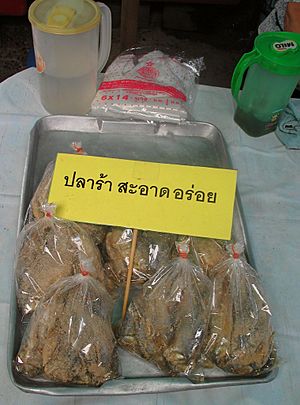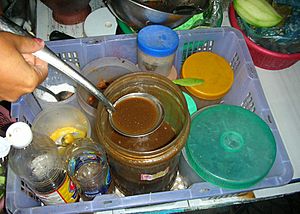Pla ra facts for kids


Pla ra (Thai: ปลาร้า) is a traditional Thai seasoning. It's made by fermenting fish with rice bran or roasted rice flour and salt. This mixture is kept in a closed container for at least six months.
Pla ra is similar to a food called padaek in Laos. You can find fermented fish seasonings like pla ra in many Southeast Asian countries, including Cambodia, Laos, Thailand, and Vietnam. Pla ra has a very strong smell, which some people might find unusual. It tastes salty and sour. The exact flavor depends on how much salt is used and how much lactic acid forms during the fermentation process.
Contents
History of Pla Ra
Pla ra was a common food in the Ayutthaya Kingdom a long time ago. A French diplomat named Simon de la Loubère visited Siam (which is now Thailand) in the 1600s. He wrote about the food habits of the Siamese people.
He explained that their main foods were rice and fish. The Siamese people didn't really like to eat fresh fish. Instead, Fermented fish was very popular, much like spicy Thai dips called Nam phrik. When Simon de la Loubère returned to France, he even took some pla ra with him!
Types of Pla Ra
Pla ra is sorted into different types based on what it's made with.
One type of pla ra is fermented with roasted rice powder. This kind becomes yellow and has a soft texture. It also has a special smell. This type is often used as a paste and is usually made in central Thailand. It often uses striped snakehead fish or catfish.
Another type of pla ra is fermented with rice bran. This product is usually clear black and has an even stronger smell. The fish in it is softer and smaller. This type is mostly found in northeastern Thailand. People use it as an ingredient in dishes or sometimes eat it raw.
There are also two other terms for pla ra:
- Pla ra sot: This means "fresh pla ra." It uses fresh fish and tastes salty with a little sourness from lactic acid.
- Pla ra lom: This type uses fish that has already started to break down (called an autolysis reaction) until it has a strong smell. Sometimes, fish is soaked in water for 12–24 hours to make it softer before fermentation.
How Pla Ra is Made
There are different ways to make pla ra. One common method has two main steps:
- First, fish is fermented with salt until it becomes softer.
- Then, it's fermented again with rice bran or roasted rice powder. This second step gives it its special smell and flavor.
Another way is to ferment the fish with salt and crushed, toasted glutinous rice for at least six months.
Here's a step-by-step look at the process:
- First, the fish is cut into small pieces and mixed with salt.
- After 24 hours, the fish is packed tightly into a container, usually a pot.
- Salt water is then poured over the fish until the container is full.
- The container is sealed and left for three months.
- After three months, this first stage of pla ra is mixed with rice bran or roasted rice powder.
- It's then put back into the container and sealed again for two more months, or even longer.
In 2018, the Thai Ministry of Agriculture created rules to make sure that pla ra sold in stores is good quality and clean.
Dishes with Pla Ra
Pla ra is often eaten raw or used to make a spicy chili fish sauce called nam phrik pla ra.
To make nam phrik pla ra, people roast green pepper, garlic, shallots, and boiled fish meat. All these ingredients are ground together. Then, boiled fermented fish liquid, fish sauce, and lime juice are added to the mixture. This sauce is often used for dipping vegetables or eaten with rice.
Pla ra can also be made into a powder. This is done by baking it with some spices until it's dry, and then grinding it all together. Nam phrik pla ra and Pla ra song krueng (also called lon pla ra) are popular dishes in Thailand's Central Region.
Nutrition in Pla Ra
Pla ra contains many different nutrients. Here's a quick look at what's inside:
| Composition | Amount |
|---|---|
| Protein | 16.08–18.94% |
| Moisture | 28.90–71.48% |
| Fat | 0.71–3.20% |
| Salt | 5.23–9.14% |
| Calcium | 1505.06 mg % |
| Phosphorus | 661.75 mg % |
| Vitamin B12 | 2.175±1.78 mg % |
| pH | 4.5–6.2 |
| Lactic acid | 0.3–1.90 |
| Microorganisms | 2.2x106—8.8x107 |
Many types of bacteria are found in pla ra. Some important ones include:
- Pediococcus halophilus
- Staphylococcus epidermidis
- Micrococcus species
- Bacillus subtilis and Bacillus licheniformis
Pediococcus halophilus is the most common type of bacteria when pla ra ferments for three to five months. Studies show that 90% of pla ra samples from markets have this bacteria. This means it plays a very important role in making pla ra taste and smell the way it does. Other types of Pediococcus also help with the taste and smell. The Staphylococcus, Micrococcus, and Bacillus bacteria help break down the proteins in the fish.
See also
 In Spanish: Pla raa para niños
In Spanish: Pla raa para niños

